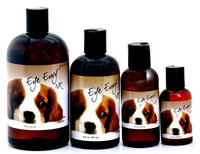The Ultimate Guide to Pet Tear Stains
Tear stains are usually caused by epiphora, which is basically excessive tear production. Tear stains are usually reddish-brown streaks that are found under your pet's eyes and are most noticeable on pets with white or light fur coats. Tear stains are not necessarily harmful to your pet, and in most cases they aren't anything more than a minor annoyance. However, it could be a sign that your pet has an underlying eye issue.
Porphyrins are molecules containing iron that occur naturally in your pet’s body. In most cases, these waste products are removed from the body through your pet’s bowel movements, however, in dogs and cats, porphyrin can also be removed and excreted through urine, saliva, and tears. As porphyrins escape through saliva and tears, staining will naturally occur over time and will even darken when exposed to sunlight.
While most tear stains are reddish-brown in color, if your pet shows a darker brown color, you pet may have developed a yeast infection and should be treated accordingly. If your pet’s face has a smell in conjunction with the darker brown color stain, a yeast infection is most likely the culprit. Keep in mind that pets can have both a tear stain caused by porphyrins and also have a secondary yeast infection. It’s also helpful to know whether you should use products to treat brown stains or rust colored ones.
Which animals are susceptible to tear stains?
Dogs and cats are the most common species of animal to be susceptible to tear stains and in certain breeds, especially in the toy category.
The most common dog breeds include:
- Bichon Frise
- Shih-Tzu
- Maltese
- Poodles
- Cocker Spaniels
- Pekinese
- Pugs
- Bulldogs
The most common cat breeds include:
- Exotic shorthairs
- Persians
- Himalayans
Also, with the creation of hybrid breeds, there has been an increase in tear stains in these breeds as well. Because hybrid breeds may not have common traits similar to traditional tear staining breeds, the signs might not be as obvious. For example, breeds with small noses or flat-faced breeds are known for having tear stain issues, whereas many of the hybrid breeds have long snouts and normal inset eyes, which aren’t features typically found in breeds with tear stain issues.
Common hybrid breeds include:
- Goldendoodle: Golden Retriever (Non-Tearer) + Poodle (Tearer)
- Cavashu: Cavalier King Charles (Tearer) + Shih Tzu (Tearer)
- Puggle: Pug (Tearer) + Beagle (Non-Tearer)
- Maltipoo: Maltese (Tearer) + Poodle (Tearer)
While these are just a few to name, keep in mind that lighter coat breeds will show tear stains more so than darker ones.
How to prevent tear stains
There have been mixed research on whether tear stains are an external issue, an internal issue, or both. Besides keeping your pet’s face clean and free of moisture, here are some suggestions to help prevent tear stains on your pet:
- Keep your pet’s face hair trimmed. If you’re unable to keep the hair around your pet’s face trimmed on your own, schedule regular appointments with a groomer. This will help keep your pet’s face neat and clean and will assist in keeping unnecessary debris out of their face.
- Consider daily eye and mouth-hair hygiene in addition to keeping your pet’s face hair trimmed. A quick daily check can go a long way to help avoid tear stains. A quick flush of the eyes with an eyewash or other saline eyewash solution should be included in your routine. Dry or waterless shampoos can also be used to keep muzzle hair clean.
- Consider examining the quality of your dog food. Feeding your pet a high quality, balanced diet is always recommended. If possible, avoid feeding your pets brands of food that use filler-type products. A good diet will ensure your pet has a good long-term health and will help avoid allergic reactions, which is one possible cause of excessive tearing.
- What’s your water like? Provide fresh, filtered drinking water instead of tap. Tap water can contain high amounts of iron, other mineral content, or impurities. Chlorine and fluoride, when consumed by pets, can be toxic. Excess minerals can cause tear stains.
- Replace plastic bowls. Plastic bowls can harbor bacteria over time, especially if they aren’t being cleaned on a regular basis. Bacteria can irritate your pet’s face and linger which may be a possible cause for tear staining. Some pet owners will even use glass water bottles similar to those made for birds instead of water bowls to help absorb excess water around your pet’s mouth.
- Use cornstarch. To help keep the eye, muzzle, and toe area free of moisture, some pet owners have used a small amount of cornstarch dusted in these areas to soak up any excess moisture.
How to care for and remove pet tear stains
Before beginning any type of treatment of tear stains, it is important to rule out any possible medical issues by speaking with your veterinarian. Some medical causes for tear staining may include the following:
- Ingrown eyelashes
- Teething
- Allergies
- Narrow or small noses
- Large eyes
- Irritation
- Eye infection
- Large tear glands
- Small tear duct openings
- Glaucoma
- Inverted eyelid
- Ear infection
- Exposure to smoke
- Poor-quality diet
- Stress
- Yeast infection
- Side effects from medication
Once you’ve determined that there are no medical causes for your pet’s tear stains you can safely begin treatment. One thing to note before beginning treatment for tear stains is having realistic expectations during the removal process.
Unfortunately, there’s no instant miracle to remove tear stains on your pet, however, there are ways to teach pet owners like yourself how to clean the stains that your pets currently have, and also how to help improve and avoid future staining in other areas. Each pet and breed will have varying results when it comes to removing tear stains so it’s important to be patient and understand that the removal process will take time. Take a look at these before and after pictures from the use of Eye Envy Tear Stain Remover.
Contributing factors to consider in addition to the type and breed of animal is also the type of fur, how stains have been treated in the past, and how bad the stains are currently. If your pet has been treated with antibiotics or any type of whitening or brightening shampoo can also add to the process time.
In addition to the suggestions mentioned above to help prevent tear stains, we recommend the use of a tear stain remover such as the Eye Envy Tear Stain Remover for Dogs or the Eye Envy Tear Stain Remover for Cats.
Eye Envy Tear Stain Remover
The Eye Envy Tear Stain Remover includes a cleanser to clean the infected area while removing any debris, and also includes an organic astringent to help dry the area and help stop the growth and spread of bacteria. Lastly, our cleanser kit includes a natural antibacterial product that helps mimic the properties of an antibiotic to stop the infection.
When treating bacteria, it is important to note that bacteria tends to grow and spread in environments where there’s moisture, darkness, and warmth. This is why it’s key to ensure the hair and surrounding areas of your pet’s face are kept moisture-free and clean.
Here at Eye Envy, we have taken special care to ensure all of our products are safe and effective for your pets and as well as for you. We do not use any preservatives in any of our products including our tear stain remover. We do not use bleach, hydrogen peroxide, alcohol, or any type of chemical that could cause any harm to your pet.
While many competitor brands contain whitening or brightening chemicals in attempt to fix tear stains quickly, we at Eye Envy want to offer the best and safest way to help remove and prevent tear stains, even if it takes longer to do so.
For many of us, our pets aren’t just pets. They are a part of our family. That’s why having an effective but safe product is our top priority and we would never use a product on our furry friends that we wouldn’t use on our own children. As you try new products to remove tear stains, please consider the safety of your pet and check to make sure there aren’t any harmful chemicals that could harm your pet.
If you would like to try the Eye Envy Tear Stain Remover for Dogs or the Eye Envy Tear Stain Remover for Cats, we welcome any questions you may have. Feel free to contact us with any questions or concerns or if you would like more information on our natural products.
Also, Eye Envy doesn’t just make tear stain removers, we also makes products to treat the needs of your pet’s ear, nose, paw, and beard. Feel free to browse our available products here. Again, should you have any questions about tear stains, systems to help treat your pet’s ear, nose, paw, or beard, or if you’re just looking for safe and effective shampoo, we’re here to help each step of the way. Contact us today!

